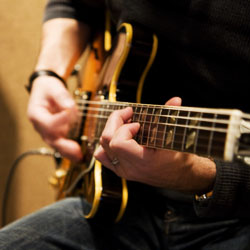
Jimi Hendrix (Then and Now)
Jimi Hendrix’s tone is possibly the most emulated of all time, so many manufacturers have devoted considerable resources to recreating the gear that helped shape Hendrix’s tone, but is no longer available (or is too rare and expensive to come by easily).
First, a look at Hendrix’s original setup. Hendrix went first into a Cry Baby or Vox wah and then into a fuzz.
He used primarily two: an Axis Fuzz and the Roger Mayer–designed Fuzz Face.
From there he went into a Dunlop Uni-Vibe and Mayer Octavia before going into a 6550-equipped Marshall.
For the modern Hendrix sound, the Dunlop Cry Baby is the wah of choice, and then distortion units by Fulltone (Fuzz) or Prescription Electronics (Experience Fuzz) are considered de rigueur.
Fulltone makes the DejáVibe that closely emulates the original for a fraction of the price. For that square-wave octave sound, the Boss OC-2 does a nice job.
Much has been made of the fact that Hendrix played a right-handed guitar flipped upside down and strung left-handed.
This means that as a left-hander himself, Hendrix played the guitar conventionally, but there were several key differences in the imposition of his instrument:
1. The string tensions were all different, because Strats normally have the first string as the longest.
By reversing the strings on the Strat’s inline tuner configuration, the sixth string became the longest, and the increased tension on the thickest string significantly changed the resonant properties of the guitar.
2. The pickups were angled the “wrong” way, with the bridge pickup slanted toward the neck instead of the bridge.
This placed the first-string pole piece well up from the bridge instead of right next to it, as on a normally strung guitar. (The pole-piece heights were all different as well.)
3. The bar and the controls were above the right hand. While this may not affect the guitar’s tone per se, it affects the way a performer approaches the instrument, and we know from listening to Hendrix’s music that this was perhaps the most influential element on his tone.

